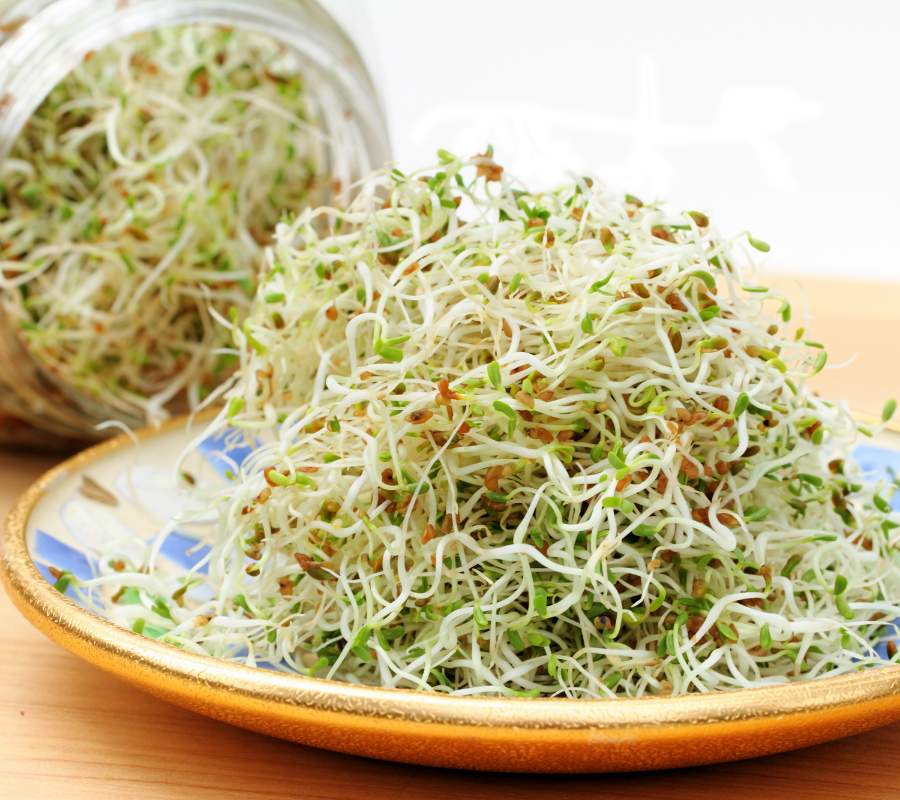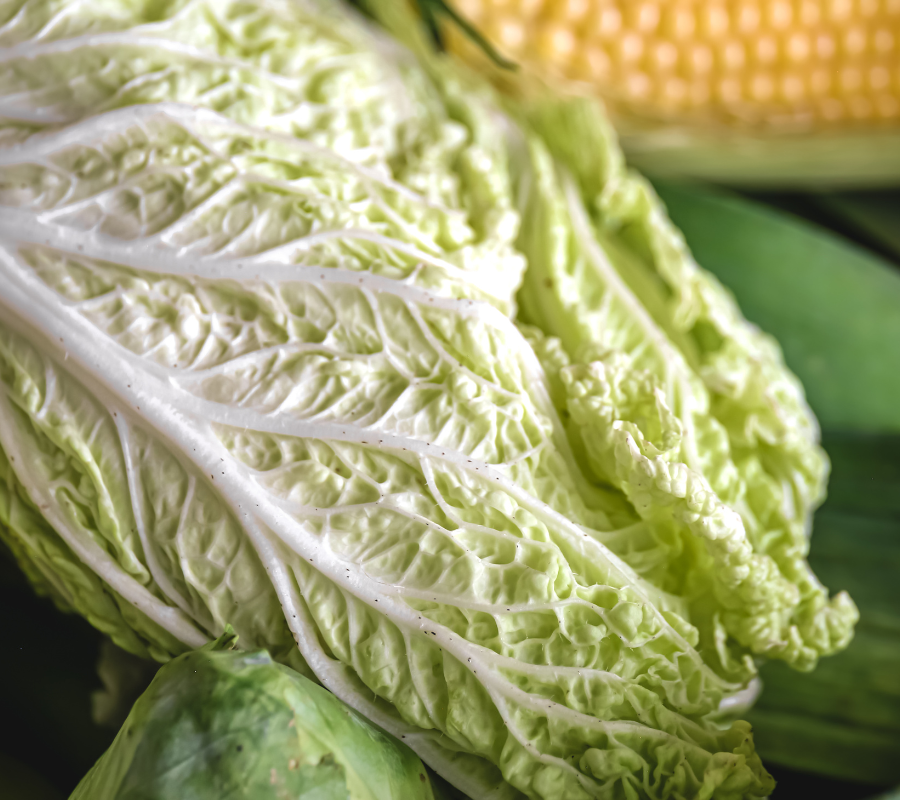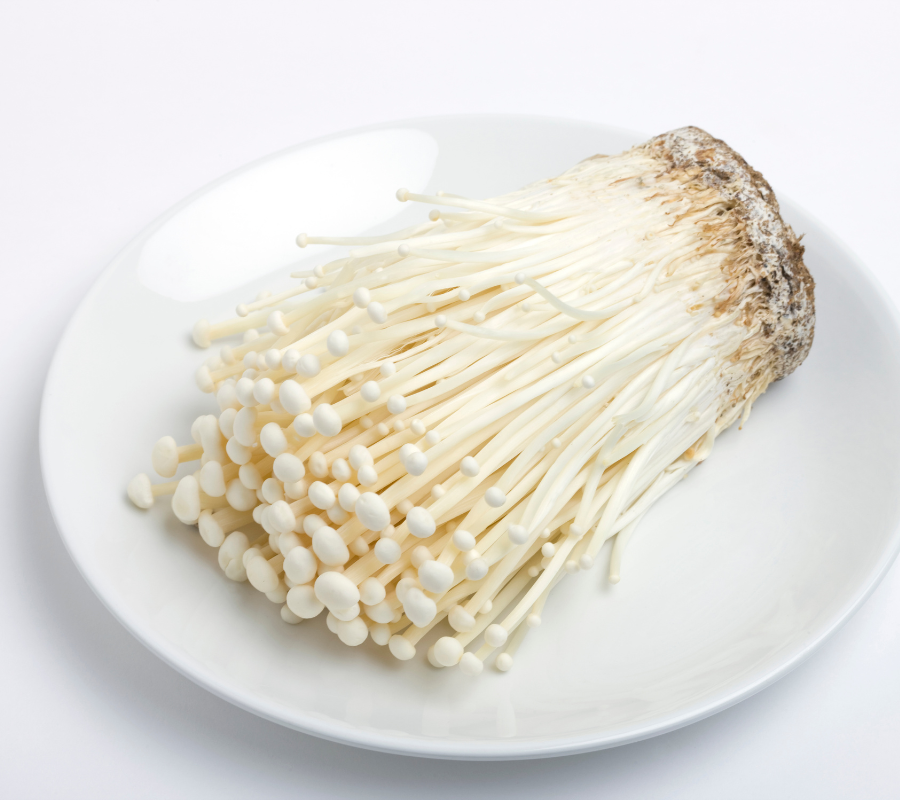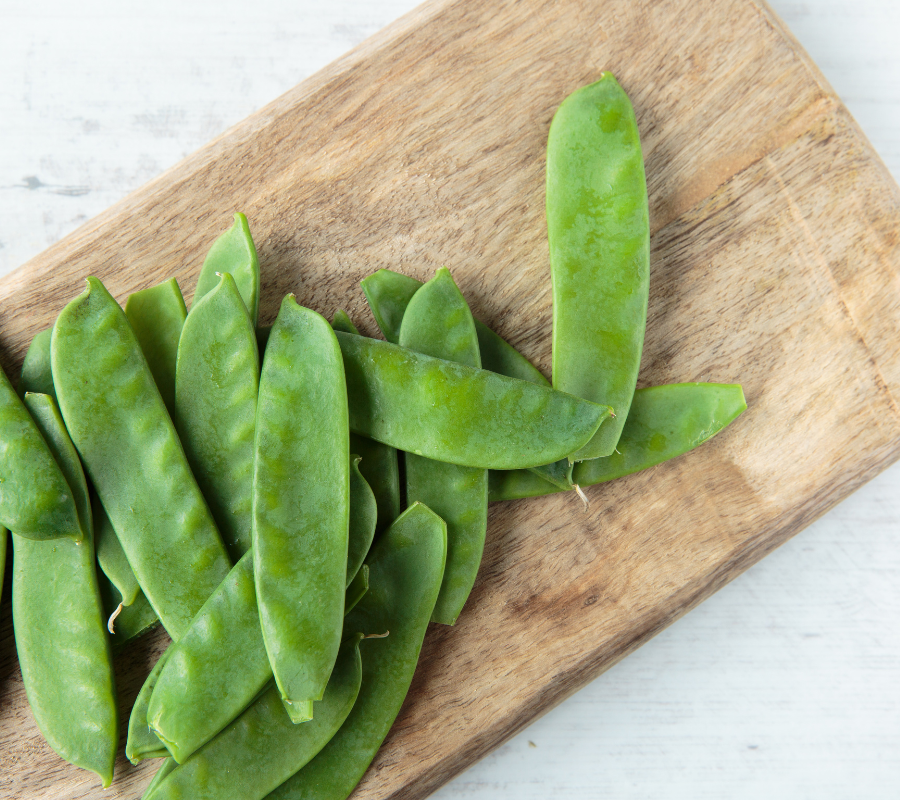Substitutes for Bean Sprouts: Next Best Thing for Your Recipes
What happens when you’re midway through your recipe and realise you’re out of this essential ingredient, bean sprouts? What substitute is there for bean sprouts?
Fortunately, the world of vegetables and legumes offers a plethora of best bean sprout substitutes to save the day.
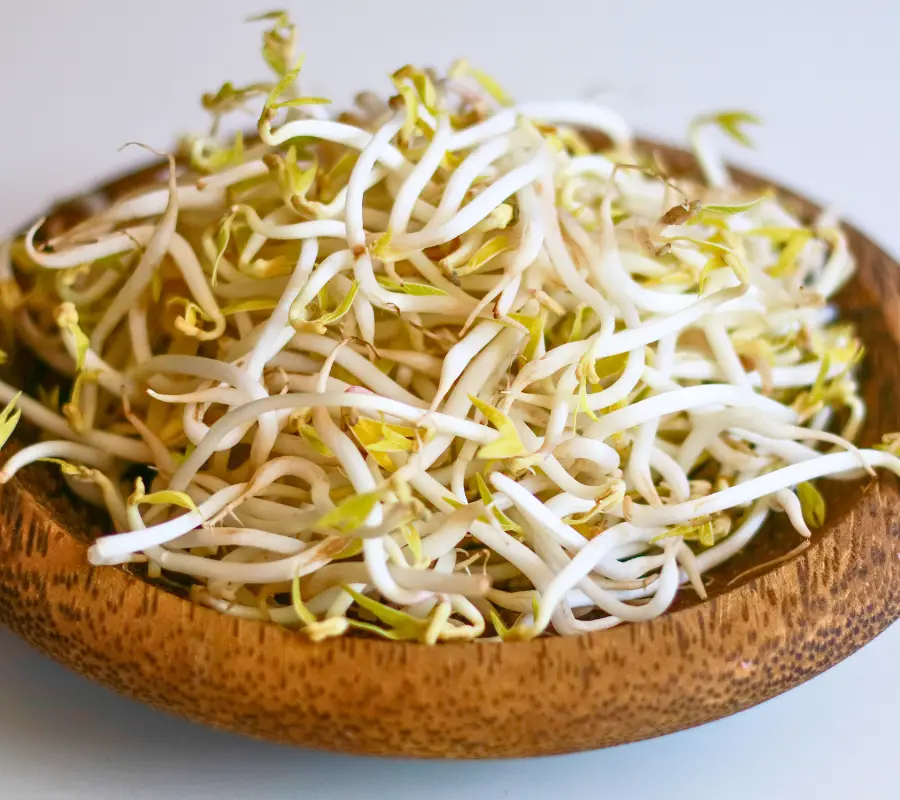
If you find yourself without this popular ingredient, a wide range of alternative ingredients stands ready to maintain the taste and texture balance of various dishes.
Substitutes for Bean Sprouts
Ingredients such as mung beans, snow peas, and napa cabbage have become excellent substitutes for their similar crunchy texture.
For those craving the delicate flavour of fresh bean sprouts, enoki mushrooms and alfalfa sprouts offer a great alternative, delivering the same culinary delight.
I often use very thin strips of celery sticks or tinned water chestnuts for the same texture.
It’s comforting to know that your local grocery store likely harbours an array of substitutes for bean sprouts, ensuring that your Asian cuisines can still feature that perfect ingredient to complete the meal.
Alfafa Sprouts Chinese Cabbage Enoki Mushrooms Snow Peas
Key Takeaways
- A variety of legumes and vegetables, like snow peas and napa cabbage, can replicate the crisp texture and mild flavour of bean sprouts.
- Enoki mushrooms and alfalfa sprouts serve as an excellent substitute for bean sprouts in Asian dishes, ensuring similar taste profiles.
- Your local grocery store typically has multiple alternatives, making it easy to find a suitable substitute for bean sprouts in a pinch.
Understanding Bean Sprouts
Bean sprouts, known for their crunchy texture and mild flavour, are a popular ingredient in various culinary traditions, particularly in Asian dishes. They originate from different types of beans, with mung beans and soybeans being the most commonly sprouted varieties.
What Are Bean Sprouts
Bean sprouts come from the germination of beans such as the mung bean, also known as green gram and soybeans. This process involves soaking beans in water and then allowing them to sprout in a dark place, typically a warm environment. Mung bean sprouts are slender with a mild flavour, whereas soybean sprouts are thicker with a nuttier flavour.
Nutritional Profile
Bean sprouts are a nutritious addition to any meal, providing a good source of protein, iron, and vitamin C. They also supply essential vitamins and minerals, including potassium, calcium, fibre, and vitamins K and C. Their high nutrient content makes them a valuable ingredient for maintaining a balanced diet.
Nutritional Breakdown (per 100g of mung bean sprouts):
- Calories: 30 kcal
- Protein: 3 g
- Fiber: 0.8 g
- Iron: 0.91 mg
- Vitamin C: 13.2 mg
- Potassium: 149 mg
Culinary Uses
Bean sprouts are a versatile ingredient, often used fresh to add a crisp texture to salads and sandwiches. Cooked, they’re commonly found in stir-fries, soups, and Asian dishes like pad thai.
Their delicate flavour makes them perfect for absorbing the bold tastes they’re combined with, and they serve well as a topping or mixed in with other ingredients to enhance a dish’s overall texture and appeal.
Choosing Substitutes for Bean Sprouts
When your recipe calls for bean sprouts, and you find yourself without them, there’s no need to fret. With a variety of textures and flavours available in other ingredients, you can mimic the crunch and nutritional profile of traditional bean sprouts with ease.
Texture-Based Substitutes
For the crispy texture that bean sprouts provide, alternatives like shredded carrots, bamboo shoots, and water chestnuts offer a similar crunchy texture. These substitutes work exceptionally well in stir-fry dishes and spring rolls, where maintaining that crisp texture is key.
Snow peas and enoki mushrooms can also serve as a great alternative, especially in Asian cuisine, where the crunch of bean sprouts is often desired.
- Enoki mushrooms: Thin and with a mild flavour, they add a delicate snap to your meals.
- Snow peas: Their edible pea pods offer that desirable crispy bite.
Flavor-Focused Alternatives
If it’s the subtle, slightly nutty flavour of bean sprouts you’re looking to replace, consider sunflower sprouts, alfalfa sprouts, or soybean sprouts as some of the best bean sprout substitutes. They can be strewn over Southeast Asian dishes for that nutty flavour without overpowering other ingredients.
These sprouts tend to be available in most grocery stores and are a good substitute in a variety of dishes.
- Alfalfa sprouts: A good source of protein with a mild flavour that complements many Asian dishes.
- Soybean sprouts: Slightly larger and with a stronger bean flavour, they’re an excellent substitute in Asian markets.
Nutrition Equivalents
When prioritising the nutritional aspect, particularly for those rich in vitamin C and essential amino acids, mung beans and other leafy greens can offer comparable benefits.
Alfalfa sprouts and sunflower seeds are packed with nutrients, making them an excellent choice as a substitute for bean sprouts in various cuisines.
- Bok choy (bok choi): Offers an array of vitamins and a peppery flavour, acting as a suitable substitute for vitamin K in bean sprouts.
- Napa cabbage: A versatile green with a similar texture and nutritional profile to fresh bean sprouts.
Vegetable Alternatives
When seeking a replacement for bean sprouts in your cooking, various vegetable alternatives offer a similar crunch and nutritional value. These replacements can be found across three categories: leafy greens, stems and bulbs, and pods and seeds, each offering a distinct texture and taste profile to match that of traditional bean sprouts.
Leafy Greens Options
Leafy greens like bok choy and Chinese cabbage are among the best substitutes for bean sprouts due to their crisp texture and mild flavour. For a similar crunchy texture to fresh bean sprouts, consider napa cabbage or watercress.
These greens provide a nutritious punch, high in vitamin C, and maintain their structural integrity when added to Asian dishes.
- Bok Choy: A staple in Asian cuisine, it’s a great alternative for the crunch of bean sprouts in stir-fry dishes.
- Chinese Cabbage: Whether you opt for napa or green cabbage, their crispy texture and delicate flavour make them an excellent substitute in recipes like spring rolls.
Stem and Bulb Variants
Switching from bean sprouts to stem and bulb veggies can maintain a recipe’s textural elements while adding a new taste dimension. Celery, green onions, and radishes offer a refreshing crunch and juiciness that mimics the crunch of bean sprouts.
- Celery: With its juicy bite and herbal flavour, celery is a good substitute and available at your local grocery store.
- Green Onion: For a slightly sweet and savoury note, use thin strips of green onion as a suitable substitute.
Pod and Seed Choices
Edible pea pods and various seeds can also serve as substitutes, contributing a nutty flavour and crispy texture to your favourite Asian recipes.
Snow peas and snap peas are excellent for their juicy bite, while seeds like sunflower and alfalfa sprouts can add textural contrast to dishes.
- Snow Peas: A common ingredient in Chinese cuisine, snow peas provide an excellent choice in stir-fried dishes, and their edible pea pods have a similar crunchy texture to bean sprouts.
- Sunflower Seeds: Try using sunflower seeds or sunflower sprouts for added crunch and a nutty flavour as a perfect ingredient in both raw and savoury dishes.
Legume and Seed Substitutes
When looking for the best substitutes for bean sprouts, your top picks should be other sprouted legumes and seed sprouts, as they offer complementary nutrition profiles and textures. These alternatives retain a high protein content and integrate seamlessly into a vast array of dishes, making them ideal for anyone seeking a similar culinary experience.
Sprouted Legume Alternatives
Sprouted legumes like lentil sprouts and chickpeas are some of the best substitutes you can find. Easily sprouted at home or available in many grocery stores, these sprouts bring a similar crisp texture and are a good source of protein.
Lentil sprouts present a slightly more nutty flavour compared to the mild flavour of mung beans, but they’re still a great alternative for your favourite dishes, including stir-fry dishes and spring rolls.
Enlisting soybean sprouts as an alternative offers a stronger bean flavour and a similar crunchy texture that is characteristic of traditional bean sprouts.
Widely used in Asian cuisine, soybean sprouts are often incorporated into stir-fried dishes and can be found with relative ease at Asian markets.
Nut and Seed Sprouts
Moving on to nut and seed-based options, sunflower sprouts — sprouted from sunflower seeds — stand out as an excellent substitute. These sprouts not only have a satisfying crunch but also provide a bounty of nutrition. They contain essential amino acids and vitamin C.
Perfect for salads and sandwiches, sunflower sprouts deliver a delicate flavor that won’t overpower the taste of bean sprouts.
Alfalfa sprouts are another excellent choice, offering a mild flavour that can blend into a variety of dishes without dominating other flavours. Though their texture isn’t as crisp as fresh bean sprouts, they still supply a pleasant crunch. They are also a versatile ingredient in both Asian and Western cuisines.
These alternative ingredients allow you to maintain the nutritional balance and crisp texture in your meals. This ensures the next time preparing various dishes, you won’t miss the distinctive crunch of bean sprouts.
Utilising Substitutes in Dishes
When fresh bean sprouts aren’t available for your cooking endeavours, knowing the right substitutes can ensure your dishes retain the desirable crunch and flavour profiles characteristic of the original ingredient. Explore how to integrate alternative ingredients into different cuisines and embrace their unique qualities.
Asian Cuisine Applications
In Asian dishes, where mung bean sprouts commonly provide a crisp texture, substituting with vegetables such as snow peas or bamboo shoots can offer a similar crunchy texture.
For a stir-fry, thinly sliced bok choy can be a great alternative, giving a mild flavour and crispy texture in place of bean sprouts.
If you’re prepping spring rolls or pad thai, enoki mushrooms have a delicate flavour and a similar texture that complements the other ingredients well.
- Sunflower sprouts can also be used in stir-fried dishes, providing a nutty flavour.
- Napa cabbage, cut into thin strips, can be an excellent choice in various Chinese recipes, mimicking the crunch of bean sprouts.
Western Dish Adaptations
Switching to Western cuisines, alfalfa sprouts can be used in sandwiches and salads for a light, herbal flavour.
Green cabbage or napa cabbage shredded finely, acts as a suitable substitute in terms of taste and texture for casseroles and stews.
Try soybean sprouts for a stronger bean flavour in savoury dishes; they are a good source of protein and hold up well to heat.
- Small sprouts, like those from radish or sunflower seeds, can be a good substitute in various Western dishes, adding a surprising crunch.
- In salads, leafy greens can be utilised for their chewy texture and nutritional benefits such as vitamin C and K.
Creative Cooking Ideas
Creating your own bean sprouts from mung bean seeds at home is easier than you might think.
Simply soak the green gram in warm water, then drain and store in a dark place. Rinse and drain with fresh water every day.
In a few days, you’ll have crispy, nutty mung bean sprouts.
- Water chestnuts and edible pea pods offer a sweet taste and crunch, perfect for when you need the texture of traditional bean sprouts.
- Bell peppers, cut into thin strips, can add colour and crunch to your favourite dishes, serving as an excellent substitute for bean sprouts.
Preparation and Storage Tips
When seeking to maintain the crisp texture and delicate flavour of bean sprout substitutes, proper handling and storage are paramount. Here’s how you can make sure your alternatives stay as fresh and tasty as possible.
Handling Fresh Substitutes
Upon selecting fresh bean sprouts or their alternatives like bok choi or snow pea shoots at your local grocery store, it’s essential to keep them cool and dry until you’re ready to use them.
If you opt for alfalfa sprouts or sunflower sprouts, make sure to rinse them in cold water and pat them dry with paper towels before use.
This will not only clean them but also help to remove excess moisture that could hasten spoilage.
Storing Alternative Options
For long-term storage, most fresh substitutes, including mung bean sprouts and soybean sprouts, should be refrigerated in a sealed container. Line the container with a paper towel to absorb any additional moisture, which can help preserve their crispy texture.
- Canned bean sprouts or canned beans, once opened, ought to be transferred to a container and kept in the fridge for no more than a few days.
- Leafy greens like napa cabbage, which can act as a great substitute in Asian cuisine, should be kept in a crisper drawer to maintain their crunch.
- To store tofu, which is a versatile ingredient and a good source of protein, immerse it in cold water in an airtight container and change the water daily.
For green cabbage or shredded cabbage, options that have a similar texture to traditional bean sprouts and are commonly used in stir-fry dishes, you may wrap them in cling film and refrigerate to retain their vitamin C and freshness.
Bell peppers, sliced into thin strips for a suitable substitute that adds a slightly sweet flavour to various dishes, should also be refrigerated in a sealed bag or container.
Frequently Asked Questions
When incorporating alternatives to bean sprouts in your favourite dishes, it’s crucial to match the characteristic crunch and subtle taste they provide. Explore suitable substitutes to achieve similar qualities for various culinary applications.
What ingredients can be used as alternatives to bean sprouts in cooking?
In cooking, you can easily replace mung bean sprouts with several alternatives. Shredded green cabbage offers a similar crunchy texture, while napa cabbage provides a mild flavour.
Snow peas and soybean sprouts can also stand in, offering a slightly sweet flavour and crisp texture respectively.
Which vegetables can substitute for bean sprouts in a Pad Thai recipe?
Snow peas, thinly sliced into strips, can be a perfect ingredient for Pad Thai, providing a similar crunchy texture.
Bok choy, julienned finely, also makes a good substitute, maintaining the integrity of the dish with its crisp texture.
How can I adapt a Pho recipe to exclude bean sprouts without losing crunch?
To maintain the essential crunch in your Pho recipe without bean sprouts, try adding thinly sliced radishes or bamboo shoots. Both ingredients offer a crisp texture that can approximate the bite of traditional bean sprouts found in Southeast Asian dishes.
Are there any suitable replacements for bean sprouts in egg roll fillings?
Alfalfa sprouts and shredded carrots are excellent substitutes for bean sprouts in egg roll fillings. While alfalfa adds a nutty flavour and tender crispness, carrots provide a slightly sweet taste and retain their texture well during cooking.
How do the nutritional values of bean sprout substitutes compare to the original?
Substitutes like soybean sprouts and sunflower sprouts carry their own beneficial nutrients. They also retain a crunch similar to mung bean sprouts. Additionally, they are good sources of protein and contain vitamins like vitamin C and K. These substitutes are comparable to traditional bean sprouts in terms of taste and healthfulness.
